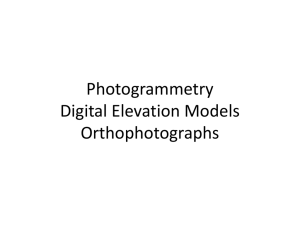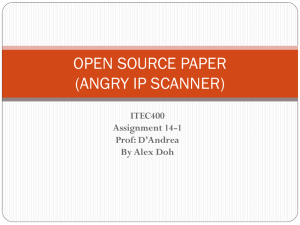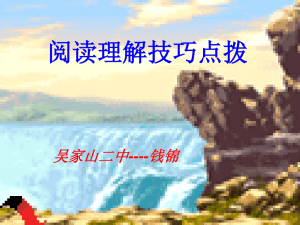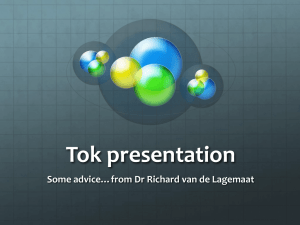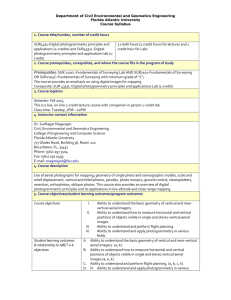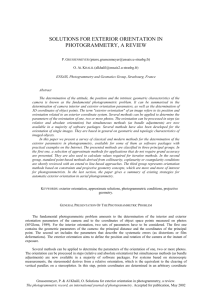PPT 1
advertisement
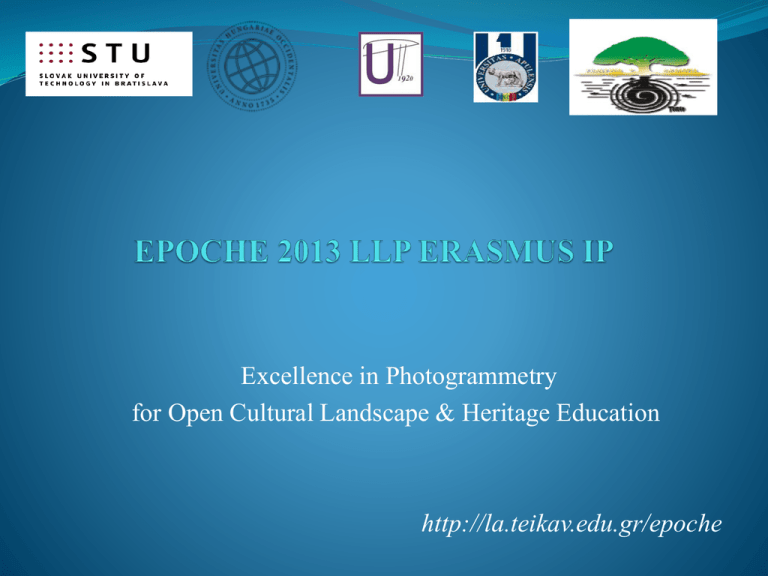
Excellence in Photogrammetry for Open Cultural Landscape & Heritage Education http://la.teikav.edu.gr/epoche Project Thesis of Group “C” Stefanos – Athanasios BERGOUNIS [TEI-K, GR] Simina CIOCAN [UPT, RO] Alexandru Ionel GĂZDAC [UAB, RO] Istvan VEGH [UWH-GEO, HU] Klára MARTVOŇOVÁ [STU Svf, SK] Contents Section 1: Introduction Section 2: Digital Photogrammetry Section 3: Photogrammetric Image Processing Section 4: Digital 3D Modeling Section 5: Conclusions & Discussion Acknowledgements Bibliography & References Appendix A’: Description & Historical Data/Information of the Target Monuments Appendix B’: The 3D Modeler & The VeCAD SoftWare 1. Introduction Group 3 members came to Thassos with EPOCHE 2013 LLP ERASMUS IP in order to produce digital 3D models of the objects with historical interest. The software used was the following: VeCAD Software PhotoModeler Scanner Software AgiSoft PhotoScan Sofware Thassos is a little green and mountainous greek island which is famous for its clean beaches. The island is in front of the Macedonian dry land and the mouth of the river Nestos and it is the 12th largest by area. Thasos island is located in the northern Aegean sea approximately 7 km from the northern mainland and 20 km south-east of Kavalla, and is of generally rounded shape, without deep bays or significant peninsulas. 2. Digital Photogrammetry Digital Photogrammetry is the art of using computers to obtain the measurements of objects in a photograph. It typically involves analyzing one or more existing photographs or videos with photogrammetric software to determine spatial relationships. Although commonly used to create topographical maps, it may also be useful in a variety of industries such as architecture, manufacturing, police investigation, and even plastic surgery The Equipment Sony Alpha DSLR - a350 Camera type – Digital SLR Optical Zoom – Not Applicable Megapixels – 14.2 Image Sensor – CCD Image Stabilisation – CCD Shift LCD Monitor - 2.7 inch Flash Modes – Auto Flash, Red- eye reduction, Flash OFF Memory card slot – CompactFlash (CF), Memory Stick PRO, Memory Stick PRO Duo, Microdrive, Memory Stick Duo The Equipment SOUTH Total Station NTS-352R Reflectorless 2” Features: Extended Internal Memory (Max. 24000 Points) Handy EDM Head Complete Application Programs Convenient Data Management System Superior Waterproof & Dustproof Capabilities, IP66 Min. Reading 0.1mm The Equipment Specifications: Color: Yellow Accuracy: 2” Battery: Ni – H, Rechargeable Operating time: 8 hours (small battery), 10 hours (big battery) Charging time: 3 hours Display: LCD, 4 lines Operating temperature: -20 - +45 Dimension: L200×H350×W180 mm Weight: 5,8 kg 3. Photogrammetric Image Processing Calibration Taking photos of the calibrates figures Process Calibration Software used: a) Calib: -used to calibrate the photos -the result of the calibration is the *.dat file Creating an orthophoto-mosaic Visited the building Made a sketch Photoshooting Measured the building Creating an orthophoto-mosaic Software used: VeCAD Creating an orthophoto-mosaic - insert the calibrated photos one by one - data processing - obtaining the final result: rectified images Creating an orthophoto-mosaic Software used: AutoCAD Creating an orthophoto-mosaic Used for - better precision - to highlight the most important details: * doors * windows * brick * shape of the building Creating a 3D model of a Pillar •Visited the object •Made a sketch •Measured two distances •Photo Shooting Creating a 3D model of a Pillar Software used : PhotoModeler Scanner Creating a 3D model of a Pillar Selected 11 photos and 2 distances Imported photos in PhotoModeler Scanner Calibration of the camera Oriented the photos Found the common points Selected, referenced and processed the common points Joined the elements of the pillar Creating a 3D model of a Pillar Opened 3D view Created surfaces Created photo – set of the photos Added a new material Defined a scale, with the help of a distance Exported the 3D model in three different formats (*.dxf, *.wrl, *.3ds) Creating a 3D model of a monument • Visited the object • Made a sketch • Measured two distances • Photo Shooting Creating a 3D model of a monument Software used: PhotoModeler Scanner Creating a 3D model of a monument Selected 7 photos and 2 distances Imported photos in PhotoModeler Scanner Calibration of the camera Oriented the photos Found the common points Selected, referenced and processed the common points Joined the elements of the pillar Creating a 3D model of a monument Opened 3D view Created surfaces Defined a scale, using a distance Exported the 3D model in three different formats (*.dxf, *.wrl, *.3ds) Creating a 3D model of a statue • Visited the object • Made a sketch • Measured two distances • Photo Shooting with a Sony Alpha DSLR a350 camera Creating a 3D model of a statue Software used : AgiSoft PhotoScanner Creating a 3D model of a statue Took 20 photos and 2 distances Inserted photos Selected the area around the statue Aligned the photos Built geometry of the statue Built texture Defined a scale, using a distance Digital 3D Modeling Digital 3D Modeling Digital 3D Modeling Discussion A fascinating aspect is the fact that in the beginning of the project the object was in the centre and only the viewer was the one who was moving around it, but with the use of modern software and low cost equipment it became possible for the viewer to be the one who rotates the object. Conclusions The Excellence in Photogrammetry for Open Cultural Landscape & Heritage Education project gave a chance to develop new skills, by learning very modern and useful software. The purpose of the project was to create a 2D Model, using the VeCAD SoftWare and a 3D Model with the help of PhotoModeler Scanner Software and PhotoScan Software. An important aspect of the software is the fact that gives the opportunity to see a 3D model, which can be used for many purposes. One of these is the restoration of objects by the archeologists. Conclusions Also a benefit of the software is that it does not require a lot of preparation, needing only to have a camera with at least 3 mega pixels, which is calibrated, a measuring tape and a total station. The process of the data does not take a long time if all the equipments needed for the software to work are in place. The software also gives the chance to compare the automatic solutions to the manual ones. The importance of the projects reflects in the practical usefulness of the software in order to create 2D and 3D models of objects, using low cost photogrammetry and equipment. Acknowledgements Group 3 members came to Thassos with the EPOCHE 2013 LLP ERASMUS IP in order to produce digital 3D models of the objects with historical interest. The project was financed by the European Union. First of all, group 3 members would like to thank the Kavala Institute of Technology, Department of Landscape Architecture for their support, in providing guidance and generosity for all the software used during the project. Also we would like to thank the ERASMUS IP for the opportunity they have given us. We would like to especially thank the professional staff of the Kavala Institute of Technology, Department of Landscape Architecture, for their assistance during the project, Mr. Styliadis, Mr. Sechidis, Mr. Vassilios Tsioukas for their dedication to the project and for their participation. Acknowledgements We express our sincere gratitude to Dr. Tamás Jancsó, Mr. Gergely László, Mr. Jan ERDELYI, Mr. Alojz KOPACIK, Mr Herban Sorin, Mrs. Carmen Grecea, Mrs. Vilceanu Beatrice, Mrs. Popa Alexandra for their guidance and help. Without them our projects would not have been able to achieve the best quality. Also the group 3 members wish to thank one more time the Kavala Institute of Technology, Department of Landscape Architecture for their effort to make this experience unique, productive and agreeable Bibliography & References 1. Prof. Athanasios STYLIADIS (Historical photography-based Computer-Aided Architectural Design: Demolished buildings information modeling with reverse engineering functionality) 2.Prof. Athanasios STYLIADIS (Image-based 3D Modeling Close-Range Photogrammetry: Extraction of 3D Geometry & Quality Information) 3 Prof. Tamás JANCSO (3D modelling in the terrestrial photogrammetry 4.Dr.-Ing. Laszlo GERGELY 3D Gis Solution applied in surveying engineering 5.A/Prof. Dr.-Ing. Sorin HERBAN & Prof. Dr.-Ing. Carmen GRECEA Excellence in Photogrammetry for Open Cultural Landscape & HeritageEducation "Politehnica" University of Timisoara Presentation Bibliography & References 6.Lecturer Dr.-Ing. Alexandra POPA Low Cost Photogrammetry: Creating, Integrating and Visualization of 3D Models Using Google Platform File 7. http://la.teikav.edu.gr/epoche/ 8. http://www.geosolution.com/ 9.http://www.getsurveying.com/ 10. http://www.imaging-resource.com/ 11. http:// www.wikipedia.org Appendix A’: Description & Historical Data/Information of the Target Monuments The war memorial monument it is located in the square park in Limenas and it is from the community of Thassos, in the memory of the fallen soldiers Appendix A’: Description & Historical Data/Information of the Target Monuments The pillar is located also in the square park of Limenas and it is part of an early Christian basilica church. Appendix A’: Description & Historical Data/Information of the Target Monuments The “Crouching Lion” is a statue of a lion, located in the garden of the Archaeological Museum of Thasos. Appendix B’: The 3D Modeler & The VeCAD SoftWare The VeCAD Software VeCAD is a 2D vector graphics library. You can use it to create your own 32 bit Windows-based CAD/GIS applications written in the popular Visual IDE languages. The Library is completely documented and source code boilerplate examples are furnished in VC++, BC++, C++ Builder, Delphi and Visual Basic. VeCAD supports its own native 'VEC' format, import/export DXF, HPGL, CNC and support for the direct insertion of bitmap objects. Some of it is many features include great snapping tools, a unique multi-page data format, and, precision control over layers, line types, colors, line widths, view-ports, and text styles. The VeCAD, created originally by Oleg Kolbaskin, has been modified by Dr. Vassilios Tsioukas, to perform basic photogrammetric processes Appendix B’: The 3D Modeler & The VeCAD SoftWare PhotoModeler Scanner is a 3d scanner that provides results similar to a 3d laser scanner. This 3d scanning process produces a dense point cloud (Dense Surface Modeling, DSM) from photographs of textured surfaces of virtually any size. PhotoModeler Scanner is a sophisticated tool to build accurate Dense Surface Models and get measurements from your photos. Use PhotoModeler Scanner to build: Dense Surface Models where a large number of 3D points are needed. Models that traditionally would require a 3d laser scanner Scale-independent object modeling - model small objects or big scenes By combining SmartMatch technology and DSM the efficiency of PhotoModeler Scanner really shines. Appendix B’: The 3D Modeler & The VeCAD SoftWare Agisoft Photoscan Agisoft PhotoScan Pro allows to generate high resolution georeferenced orthophotos (up to 5 cm accuracy with GCP) and exceptionally detailed DEMs / textured polygonal models. The fully automated workflow enables a non-specialist to process thousands of aerial images on a desktop computer to produce professional class photogrammetric data. Aerial and close-range triangulation Point cloud generation (sparse / dense) Polygonal model generation (plain / textured) Setting coordinate system Digital Elevation Model (DEM) generation True orthophoto generaton Georeferencing using flight log and / or GCPs Multispectral imagery processing EPOCHE 2013 - The Group “C” members Simina CIOCAN [UPT, RO] m_misina@yahoo.com, was born in 1991, in Reșița City, Caraș - Severin County, Romania and studies at ”Politehnica” University of Timișoara, Faculty of Construction, Section Geodesy, Specialty Surveying and Land Measurements. She is interested in sports, travelling, reading. Istvan VEGH [UWH-GEO, HU] , vegh1990@gmail.com, was born in 1990, in Mor City, Fejer County, Hungary and studies at University of West Hungary, Faculty of Geoinformatics, Speciality Surveying. He is interested travelling, meeting new people and sports for example riding motorcycles. Alexandru Ionel GĂZDAC [UAB, RO] gazdac.alexandru@gmail.com was born in 1991, in Tîrgu Mureș City, Mureș County, Romania and studied at “1 Decembrie 1918” University of Alba Iulia, Faculty of Science, Section Surveying and Land Measurements. He is interested in sports. Klára MARTVOŇOVÁ [STU Svf, SK] klara.martvonova@gmail.com was born in 1990, in Dolný Kubín, Slovakia and studied at Slovak University of Technology in Bratislava in Faculty of Civil Engineering. She is interested in history. Stefanos Athanasios BERGOUNIS [TEI-K, GR] stevenbergounis@gmail.com was born in 1987 and grew up in Athens. He studied Landscape Architecture in Greece and is interested in computer programming and building. THANK YOU FOR WATCHING !




